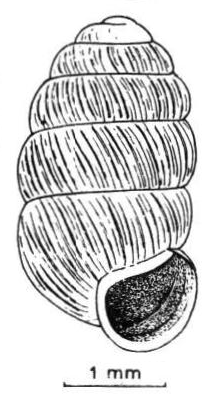Pupilla loessica
| Pupilla loessica Temporal range: early Pleistocene–Recent[1] | |
|---|---|
 | |
| Drawing of apertural view of a shell of Pupilla loessica | |
| Scientific classification | |
| Kingdom: | Animalia |
| Phylum: | Mollusca |
| Class: | Gastropoda |
| (unranked): | clade Heterobranchia clade Euthyneura clade Panpulmonata clade Eupulmonata clade Stylommatophora informal group Orthurethra |
| Superfamily: | Pupilloidea |
| Family: | Pupillidae |
| Genus: | Pupilla |
| Species: | P. loessica |
| Binomial name | |
| Pupilla loessica Ložek, 1954[2] | |
Pupilla loessica is a species of minute air-breathing land snail, a terrestrial pulmonate gastropod mollusk or micromollusk in the family Pupillidae.
Pupilla loessica is a significant glacial index species for the Pleistocene in Central and Eastern Europe and also in parts of NorthWestern Europe.[1] It lives as extant species in Central Asia.[1]
Distribution
Pupilla loessica was first described by Czech biologist Vojen Ložek in 1954 from late Pleistocene loess from Předmostí u Přerova (Moravia, Czech Republic).[1] For the Pleistocene in Central and Eastern Europe and also in parts of NorthWestern Europe, Pupilla loessica constitutes a significant glacial index species.[1]
Individual specimens had been found since the early Pleistocene.[1] It was widespread above all in the middle Pleistocene and late Pleistocene.[1]
Fossil distribution of Pupilla loessica include:
- central Europe in Pleistocene.[3] Found in loess sediments.[3]
At an early date (1986), Ložek supported the view that Pupilla loessica was alive at the present time in Central Asia.[1]
Recent distribution of Pupilla loessica include:
- Altai Mountains, Russia[1][3]
- Northern Mongolia (1670 m a.s.l.)[1]
- Baikal region (to the west of the Baikal Lake, 560 m a.s.l.), Russia[1]
- Tien Shan (3000 m a.s.l.), Kyrgyzstan[1]
Description
The shells of Pupilla loessica are about 3 mm high, thin, cylindrical-ovate and have a rounded conical apex.[1] The approximately 5 strongly curved whorls gradually increase in height and are finely and irregularly ribbed.[1] The short elliptical aperture has no denticles, no palatal callus and is only slightly broadened.[1] The crest is at most indicated by a weak band.[1]
The shells are usually a strong brown colour when fresh.[1] The fine ribs evidence very low, fragile rims which are not always visible in recent shells.[1] On weathered shells the fine ribs are still visible although less pronounced, as on the shells of the Pleistocene Pupilla loessica.[1]
The width of the recent shells is 1.6-1.8 mm.[1] The height of the shells of the recent shell is 2.5-3.3 mm.[1]
The species differs from Pupilla muscorum by its smaller size, the strongly rounded and ribbed whorls and the lack of denticles and crest.[1]
Ecology
Pupilla loessica occur from woodland to dry steppe.[3] The altitude ranges from 560 m a.s.l. to high altitude habitats around 3000 m a.s.l.[1] This species prefer continental types of habitat with average annual temperatures markedly below 0 °C.[1] The climate ranges from continental to sub-boreal climate.[1] Although it is a frequent loess mollusc, it apparently lived in various glacial habitats.[1]
Pupilla loessica is found in various different habitats in the Saylyugem Mountains.[1] These habitats range from stony steppe via open woodland with Larix sibirica, shrubland, mesophilic meadows to humid high altitude meadows with Carex sp. and Dryas oxyodonta (alpine tundra).[1]
For example in Saylyugem Mountains Pupilla loessica lives in 2200-2650 m a.s.l.[1] The closest known meteorological station is the Kosh Agach Station: the average annual temperature recorded amounts to –6.7°C (January –32°C, July 13°C) and the annual rainfall amounts to about 110-150 mm on average.[1]
This species often accompanies the so-called Pupilla fauna and Columella fauna (according to Ložek 1964).[4][1] In addition to Pupilla spp., species which like humidity, such as Columella columella or Vertigo genesii, are also often found together with Pupilla loessica.[1] The corresponding accompanying fauna is also adapted to the cold habitats, including e.g. Columella columella, Vertigo genesii, Vallonia tenuilabris, etc.[1] Such malacofauna in recent habitats (especially on the humid alpine meadows) correspond to those of the Pleistocene glacial habitats of the Central European region.[1]
References
This article incorporates CC-BY-3.0 text from the reference[1]
- 1 2 3 4 5 6 7 8 9 10 11 12 13 14 15 16 17 18 19 20 21 22 23 24 25 26 27 28 29 30 31 32 33 34 35 Meng S. & Hoffmann M. H. (2009). "Pupilla loessica Ložek 1954 (Gastropoda: Pulmonata: Pupillidae) – “A Living Fossil” in Central Asia?". Eiszeitalter und Gegenwart Quaternary Science Journal 58(1): 55–69. doi:10.3285/eg.58.1.03.
- ↑ (Czech) Ložek V. (1954). "Noví měkkýši československého pleistocénu (Neue Mollusken aus dem tschechoslowakischen Pleistozän). Vertigo pseudosubstriata sp. n., Pupilla muscorum densegyrata ssp. n. a Pupilla loessica sp. n." Anthropozoikum 3(1953): 327–342, Tab. 1.
- 1 2 3 4 Horsák M., Chytrý M., Pokryszko B. M., Danihelka J., Ermakov N., Hájek M., Hájková P., Kintrová K., Kočí M., Kubešová S., Lustyk P., Otýpková Z., Pelánková B. & Valachovič M. (2010). "Habitats of relict terrestrial snails in southern Siberia: lessons for the reconstruction of palaeoenvironments of full-glacial Europe". Journal of Biogeography 37(8): 1450-1462. doi:10.1111/j.1365-2699.2010.02280.x.
- ↑ Ložek V. (1964). Quartärmollusken der Tschechoslowakei. – Rozpravy Ústředního ústavu geologického, Praha, 31: 374 pp.